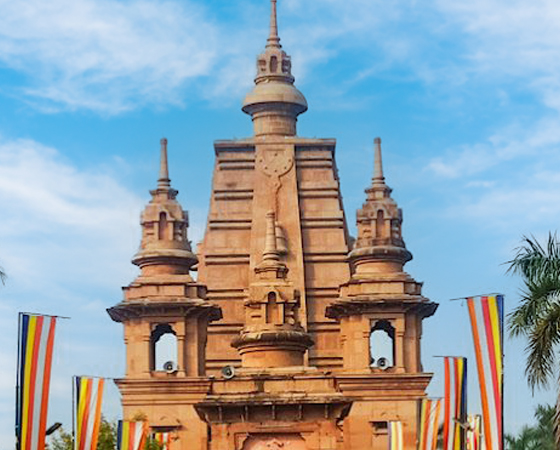Sarnath Temple
Click the 'Play' button to read out loud this webpage content
Introduction to the Sarnath Temple
Sarnath Temple is a popular Buddhist temple and pilgrimage spot situated near the convergence of the rivers Ganga and Varuna in Sarnath, Uttar Pradesh. It is also known as Mrigadava (Deer Park) and Ishipatna. Sarnath is the place where Gautama Buddha delivered his first sermon to his disciples about Maha Dharma Chakra Pravartan, which means 'wheel of dharma,' over 2,500 years ago.
It was in this place that the Buddhist Sangha (followers of Buddhism) came into existence through the enlightenment of Kondanna, a king who became a Buddha follower.

Legend of the Sarnath Temple
The Sarnath Temple has an interesting legend. According to the legend, Buddha attained enlightenment at Bodh Gaya. He delivered his first sermon, Dhammacakkappavattana Sutta, to his five disciples here. In his sermon, he taught the doctrine of Buddhism by introducing the four noble truths and his eightfold path.
This is the original place where the first Sangha was formed, and a new order of religious doctrine was laid. The Jain community also follows it and visits the Sarnath Temple as it is the spot of asceticism and the death of Shreyansanath, the 11th Tirthankara.
The Architecture of Sarnath Temple
Though the Sarnath Temple was one of the first Buddhist pilgrimage spots explored by the British, Anagarika Dharmapala, a Buddhist in the early 19th century, restored the Sarnath's damaged monuments. He raised money to restore the remnants and construct Mulagandha Kuti Vihara or Sarnath Temple – a Buddhist temple in Deer Park in 1931.
The temple's architecture showcases a blend of Mauryan and Gupta architectural styles, reflecting Buddhism's rich history and significance in the region. The architecture of the Sarnath Temple is primarily characterized by its Stupa, the main structure of the temple complex.
The main feature of the Sarnath Temple is the Dhamek Stupa. It stands at a height of 43.6 meters (143 feet) with a diameter of 28 meters (92 feet) at the base. This is built with brick and stone. Beautifully carved stones cover the bottom of the Stupa. This is believed to be the spot where Buddha gave his first sermon.
The bottom of the Stupa is circular. Stone carvings with various scenes from Buddha's life, the symbol of Buddhism, floral patterns, and lotus motifs decorate it. Many Toranas (gateways) adorn the Stupa.
An Ashoka Pillar is next to the Stupa. Emperor Ashoka built this Stupa in the 3rd century. The pillar is a polished sandstone shaft with four lion capital sculptures at the top. The lion capital of Ashoka is now the national emblem of India. Around the Stupa, there is an ambulatory path for walking.
The intricate carvings, Toranas, and the monumental Stupa make it a remarkable pilgrimage site for Buddhists and a significant cultural heritage site in India.
The main shrine comprises a golden statue of Buddha. He is sitting with his eyes closed. His hands are in front of his chest as if blessing people who pray to him. The figures of his five disciples are engraved on the base on which Buddha is sitting. He had come to Sarnath after attaining "Nirvana" at Bodh Gaya and met his first five disciples here. Many Jain monks, like the 11th Tirthankara, were born in Sarnath.
Festivals in Sarnath Temple
The most important festival, Buddha Purnima, the birthday celebration of Buddha, is celebrated in the Sarnath Temple. This day usually falls on full moon day in April / May. Pilgrims across the world come here to participate in the celebration. Prayers, processions, and sermons by senior teachers are conducted.
The temple celebrates the founding day of the Mulagandha Kuti Vihara on the first full moon of November every year. During the colorful fair, monks and scholars gather in large numbers here.
Chhath Pooja is another prominent festival celebrated in the Sarnath Temple. The Sarnath residents faithfully celebrate this important Hindu festival. They celebrate Chhath Pooja twice yearly, in Chaitra (March) and Kartik (November). The people of Sarnath dedicate this festival to the Surya Shasti, also known as the Sun. The Sarnath Temple also celebrates Dussehra in October-November.
Benefits of Worshipping at Sarnath Temple
By worshipping at this sacred place, devotees seek inspiration and blessings to attain enlightenment and deepen their understanding of the Dharma, the teachings of Buddhism.
Many believe that worshipping at Sarnath Temple brings blessings and generates positive energy through virtuous actions. It is believed to bring good fortune and positive outcomes in one's life.
How to Reach Sarnath Temple
By Road
Singhpur Bus stand is the nearest to the Sarnath Temple, which is at a 2 km distance.
By Rail
Varanasi Junction is the nearest to the temple. It is 10.3 km away from the temple.
By Air
Lal Bahadur Shastri International Airport is the nearest airport; it is at a 25.2 km distance.
Sarnath Temple Timings
The Sarnath Temple remains open from 8.00 am to 6.00 pm.
If you wish to have customized spiritual tours or pilgrimages arranged in India for yourself or for a group of people, please contact Brindavan Mystic Services
Email ID: [email protected]
Toll free: 1800 102 9098